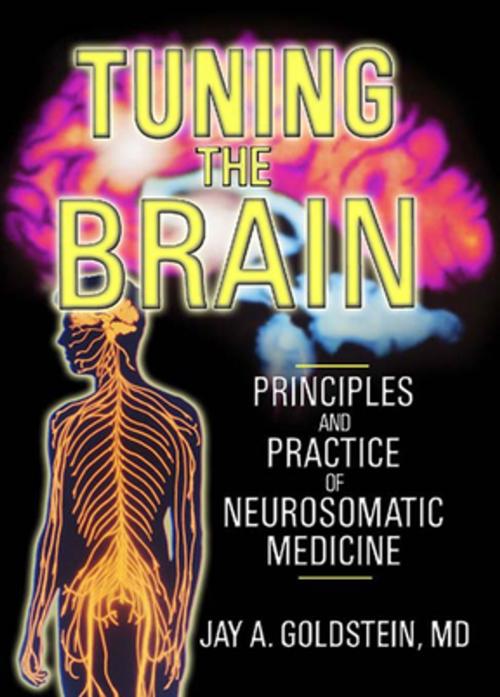Tuning the Brain
Principles and Practice of Neurosomatic Medicine
Nonfiction, Health & Well Being, Medical, Ailments & Diseases, Diseases, Allied Health Services| Author: | Jay Goldstein | ISBN: | 9781135185305 |
| Publisher: | Taylor and Francis | Publication: | October 18, 2013 |
| Imprint: | Routledge | Language: | English |
| Author: | Jay Goldstein |
| ISBN: | 9781135185305 |
| Publisher: | Taylor and Francis |
| Publication: | October 18, 2013 |
| Imprint: | Routledge |
| Language: | English |
Discover effective, outcome-oriented ways to help CFS patients who have endured useless or inappropriate treatments!
From the author: For many years I have viewed brain function as a system of electrochemical impulses continually flashing through the brain. These neural networks can often be modulated fairly simply by ’tuning’ them. The point I have been trying to make for many years is that this process may be pharmacologically regulated extremely rapidly in a manner which does not yet seem to be recognized by the medical profession.
In this remarkable volume, Dr. Jay A. Goldstein clearly presents both the theoretical and the practical aspects of his revolutionary approach to treating CFS and other conditions that have often been termed psychosomatic. Dr. Goldstein (author of Chronic Fatigue Syndromes: The Limbic Hypothesis and Betrayal by the Brain: The Neurologic Basis of Chronic Fatigue Syndrome, Fibromyalgia Syndrome, and Related Neural Network Disorders) shows how he achieves results for patients with CFS and a variety of other syndromes in days, rather than months or years.
This well-referenced book answers questions, from the most basic to the most complex, including:
- What is neurosomatic medicine?
- How did Dr. Goldstein come to pioneer and practice this specialty?
- What abnormalities in brain function produce neurosomatic disorders?
- How can an understanding of these abnormalities help you provide effective treatment?
- Why do these treatments sometimes work so rapidly?
- What is receptor profiling, and how does it indicate the type of receptor dysregulation in an individual patient?
In Part I: Inventing Neurosomatic Medicine, Dr. Goldstein describes the remarkable how and why of his life and his development of this new field of medicine, including his clashes with the medical/psychoanalytic establishment. One of the greatest medical innovators of the modern era, Dr. Goldstein has seen over 20,000 CFS patients and has experienced most of the pitfalls that having such a large number of patients entails. He shares his insight on legal issues, such as how to deal with the law and court systems, how to best provide expert testimony, and how to defend against spurious legal actions. In addition, Dr. Goldstein describes how he learned to work effectively outside of the managed care system.
In Part II: Society for Neuroscience Conference Proceedings, the author shares his expertise to bring you experimental results and pearls of wisdom relating to neurosomatic medicine from the 28th and 29th Annual Meetings of the Society for Neuroscience-the largest and most important neuroscience conference in the world. Dr. Goldstein sorted through thousands of experiments presented at the conferences to bring you the most relevant findings.
Part III: Pathophysiology and Treatment is essential reading for anyone planning to practice neurosomatic medicine. In this section, richly illustrated with over 70 pages of color figures and diagrams that make complicated concepts clear, Dr. Goldstein shares his knowledge about dozens of the agents he uses to help CFS sufferers and others manage their pain, fatigue, and other symptoms. This is information that simply cannot be found anywhere else, and will prove invaluable to all fledgling neurosomatic practitioners.
This one-of-a-kind volume is thoughtfully put together-from the extensive list of abbreviations near the beginning to the exhaustive references and an appendix with diagnostic criteria, a treatment algorithm, a medication list of treatment options available now or in the near future, and a checklist of CFS symptoms.
Discover effective, outcome-oriented ways to help CFS patients who have endured useless or inappropriate treatments!
From the author: For many years I have viewed brain function as a system of electrochemical impulses continually flashing through the brain. These neural networks can often be modulated fairly simply by ’tuning’ them. The point I have been trying to make for many years is that this process may be pharmacologically regulated extremely rapidly in a manner which does not yet seem to be recognized by the medical profession.
In this remarkable volume, Dr. Jay A. Goldstein clearly presents both the theoretical and the practical aspects of his revolutionary approach to treating CFS and other conditions that have often been termed psychosomatic. Dr. Goldstein (author of Chronic Fatigue Syndromes: The Limbic Hypothesis and Betrayal by the Brain: The Neurologic Basis of Chronic Fatigue Syndrome, Fibromyalgia Syndrome, and Related Neural Network Disorders) shows how he achieves results for patients with CFS and a variety of other syndromes in days, rather than months or years.
This well-referenced book answers questions, from the most basic to the most complex, including:
- What is neurosomatic medicine?
- How did Dr. Goldstein come to pioneer and practice this specialty?
- What abnormalities in brain function produce neurosomatic disorders?
- How can an understanding of these abnormalities help you provide effective treatment?
- Why do these treatments sometimes work so rapidly?
- What is receptor profiling, and how does it indicate the type of receptor dysregulation in an individual patient?
In Part I: Inventing Neurosomatic Medicine, Dr. Goldstein describes the remarkable how and why of his life and his development of this new field of medicine, including his clashes with the medical/psychoanalytic establishment. One of the greatest medical innovators of the modern era, Dr. Goldstein has seen over 20,000 CFS patients and has experienced most of the pitfalls that having such a large number of patients entails. He shares his insight on legal issues, such as how to deal with the law and court systems, how to best provide expert testimony, and how to defend against spurious legal actions. In addition, Dr. Goldstein describes how he learned to work effectively outside of the managed care system.
In Part II: Society for Neuroscience Conference Proceedings, the author shares his expertise to bring you experimental results and pearls of wisdom relating to neurosomatic medicine from the 28th and 29th Annual Meetings of the Society for Neuroscience-the largest and most important neuroscience conference in the world. Dr. Goldstein sorted through thousands of experiments presented at the conferences to bring you the most relevant findings.
Part III: Pathophysiology and Treatment is essential reading for anyone planning to practice neurosomatic medicine. In this section, richly illustrated with over 70 pages of color figures and diagrams that make complicated concepts clear, Dr. Goldstein shares his knowledge about dozens of the agents he uses to help CFS sufferers and others manage their pain, fatigue, and other symptoms. This is information that simply cannot be found anywhere else, and will prove invaluable to all fledgling neurosomatic practitioners.
This one-of-a-kind volume is thoughtfully put together-from the extensive list of abbreviations near the beginning to the exhaustive references and an appendix with diagnostic criteria, a treatment algorithm, a medication list of treatment options available now or in the near future, and a checklist of CFS symptoms.















